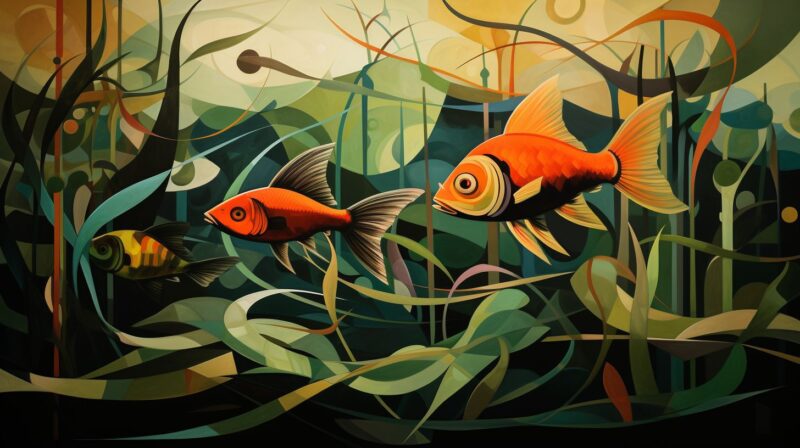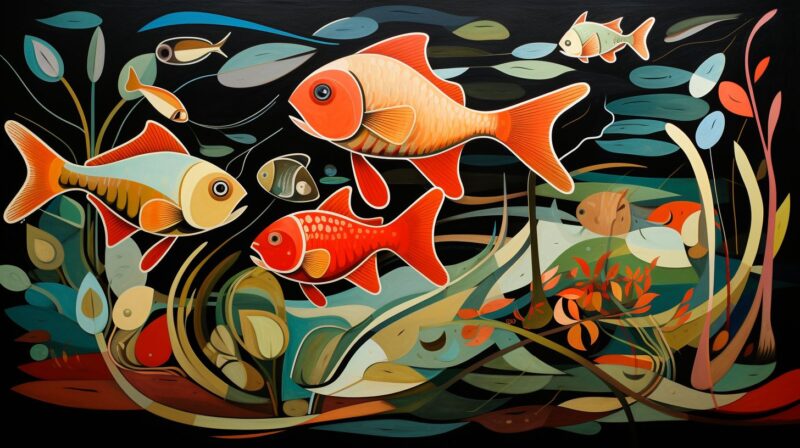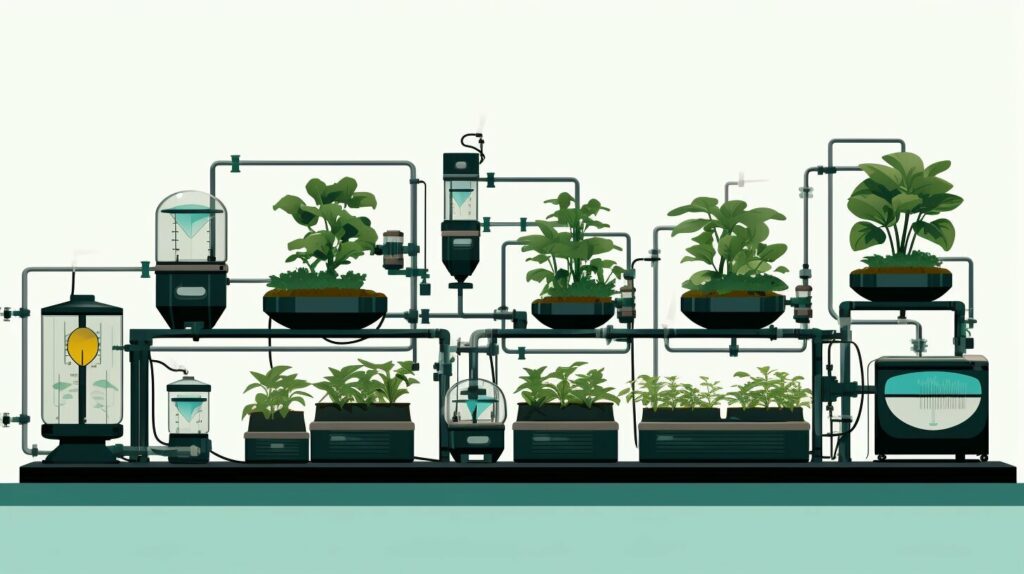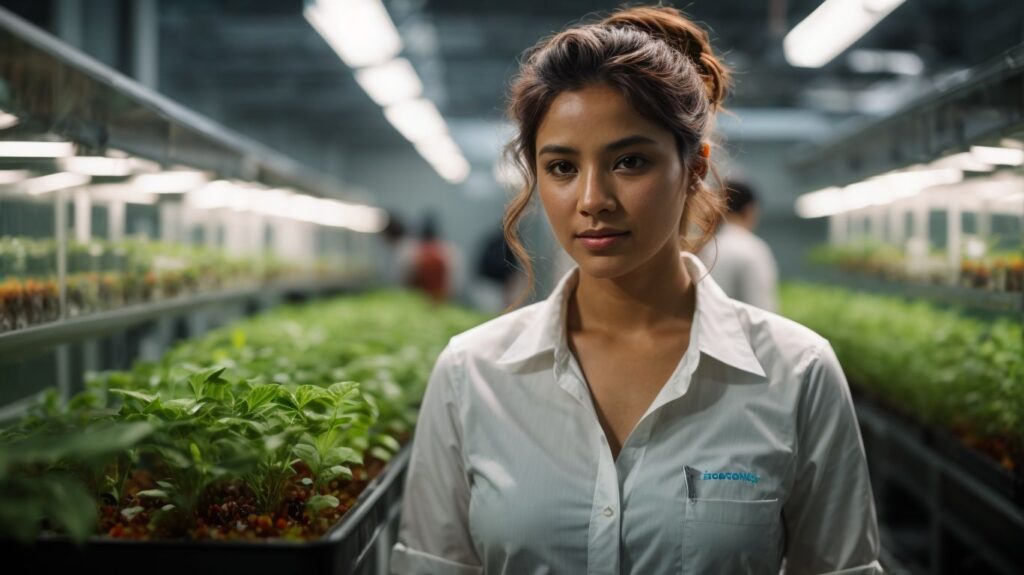This post may contain affiliate links and we may earn a small commission when you click on the links at no additional cost to you. As an Amazon Affiliate, we earn from qualifying purchases. You can read our full disclaimer here.
Aquaponics is a sustainable food production method combining aquaculture and hydroponics. It is a closed-loop system where fish waste is converted to plant nutrients, and the plants, in turn, filter the water for the fish. This symbiotic relationship between fish and plants has been around for centuries. Still, recent innovations have transformed the world of aquaponics into a more efficient, environmentally friendly, and commercially viable industry.
One of the latest innovations in aquaponics is indoor and vertical farming. With the increasing demand for locally sourced fresh produce, indoor and vertical farming have become popular solutions for urban areas with limited space and resources. These innovative systems use artificial lighting, hydroponic technology, and climate control to produce crops year-round, regardless of weather conditions.
Another significant innovation in aquaponics is using technology to monitor and control the system. Sensors and automation systems can regulate water quality, pH, temperature, and nutrient levels, optimizing the system’s performance and reducing crop failure risk. These technological advancements have made aquaponics more efficient, predictable, and profitable, contributing to the industry’s growth and success.
Key Takeaways
- Aquaponics is a sustainable food production method combining aquaculture and hydroponics.
- Indoor and vertical farming and technology have transformed the world of aquaponics into a more efficient, environmentally friendly, and commercially viable industry.
- Aquaponics offers a promising solution to the increasing demand for locally sourced and fresh produce while reducing the environmental impact of traditional agriculture.
The Core of Aquaponics: Fish and Plants Symbiosis
Aquaponics works on the symbiotic relationship between fish and plants. Fish waste gets converted into nutrients for plants to grow while the plants filter the water. This closed-loop approach is highly efficient and environmentally friendly, making it an attractive option for food production.

The Role of Fish in Nutrient Production
Fish are the core of aquaculture systems, producing the nutrients plants need to grow. Fish waste contains ammonia, converted into nitrite and then nitrate by beneficial bacteria in the system. Nitrate is a valuable nitrogen source for plants, which use it to grow and produce food.
Different fish species have different nutrient requirements and produce different amounts of waste. Some of the best fish species for aquaponics farms include tilapia, catfish, and trout. However, choosing fish suitable for your system’s climate and conditions is essential.
Plants and Their Uptake of Nutrients
Plants play a crucial role in the aquaponics system, as they absorb the nutrients the fish produce and use them to grow. In addition to providing food, plants also help to filter the water and maintain the balance of the system.
Different plants have different nutrient requirements and grow at different rates. Some of the best plants for aquaponics include lettuce, herbs, and tomatoes. It’s essential to choose plants that are suitable for the conditions of your system and to monitor the plant growth regularly.
Overall, the symbiotic relationship between fish and plants is the core of the aquaponics system. Understanding the role of fish in nutrient production and the uptake of nutrients by plants helps to create an efficient food production system.
Related Posts:
- Best Aquaponics Fish Species Suitable for Cold Climates
- How to Set Up and Maintain Aquaponics System Filters for Longevity
- Routine Care Practices for Healthy Aquaponics Plants
- Maximizing Yield in Aquaponics
- How to Treat Aquaponics Water without Harming Fish and Plants
Latest Innovations in Indoor and Vertical Farming
The Rise of Indoor Vertical Aquaponics
Indoor vertical aquaponics is a relatively new and innovative way of growing plants and fish in a controlled environment. This type of aquaponics system is becoming increasingly popular due to its many advantages. Indoor vertical aquaponics allows for year-round crop production, regardless of weather conditions, and can be set up in urban areas, providing fresh produce to local communities.
One of the fundamental benefits of indoor vertical aquaponics is the ability to save space. By stacking plants vertically, growers can produce many crops in a small area. This is especially important in urban areas where space is limited. Additionally, indoor vertical aquaponics systems can be designed to be highly efficient, using less water and energy than traditional farming methods.
To make indoor vertical aquaponics even more efficient, LED grow lights offer the right light spectrum for plants to grow and thrive. These lights are energy-efficient and can be customized to provide the optimal light spectrum for different types of plants.
Urban Agriculture: The Future of Food Production
As the global population increases, traditional farming methods struggle to keep up with the growing demand for food. Urban agriculture, including indoor vertical aquaponics, is emerging as a viable solution to this problem. Farmers can reduce transportation costs by growing food systems in urban areas and providing fresh produce to local communities.
In addition to the benefits of indoor vertical aquaponics, urban agriculture also has social and economic benefits. By creating jobs and providing fresh produce to underserved communities, urban agriculture can help to reduce poverty and improve the overall health of urban residents.
To enhance the sustainability of urban agriculture, some farmers utilize renewable energy sources, such as solar panels, to power their vertical aquaponics systems indoors. These inspiring farmers are leading the charge against climate change, spearheading efforts to diminish reliance on fossil fuels and slash harmful greenhouse gas emissions.
Related Posts:
- Plant Grow Lights for Aquaponics: A Comprehensive Guide
- Essential Guide to Pumps and Timers for Aquaponics
Environmentally Friendly and Sustainable Solutions

Aquaponics is an environmentally friendly and sustainable production system that offers a circular economy approach to food production. The technique involves cultivating plants and aquatic animals in a symbiotic relationship, where the waste produced by the animals is used as a nutrient source for the plants. This closed-loop system reduces the need for external inputs. It minimizes waste, making it an eco-friendly solution for food production.
The Circular Economy of Aquaponics
The captivating alliance between plants and aquatic creatures creates a wondrous circular economy in aquaponics. The fish produce waste, which is converted into nutrients by the bacteria in the system. The plants absorb these nutrients, which act as fertilizer and purify the fish’s water. This cycle of nutrient exchange creates a closed-loop system that requires minimal external inputs and generates very little waste.
Decoupled vs. Integrated Aquaponics Systems
Aquaponics systems can be broadly classified into two main types: decoupled and integrated. Each system offers distinct advantages and characteristics, catering to the diverse needs of aquaponics enthusiasts. Decoupled systems separate the system’s fish and plant components, allowing for greater control over each element. On the other hand, integrated systems combine the fish and plant components in a single system, creating a more natural and efficient ecosystem.
Decoupled systems are often used in commercial aquaponics operations, focusing on maximizing production. These systems require more inputs and generate more waste than integrated systems but offer greater control over the system.
Integrated systems are more commonly used in home-based aquaponics systems, focusing on sustainability and eco-friendliness. These systems require fewer inputs and generate less waste than decoupled systems. Still, they are also more complex and require a greater understanding of the natural ecosystem.
Related Posts:
Commercial Aquaponics and Food Safety
Aquaponics is a super cool and sustainable system that combines aquaculture and hydroponics to produce food. A closed-loop system lets fish and plants thrive together in a symbiotic relationship. Commercial aquaponics is gaining popularity to yield fresh, healthy, and sustainable food. However, with the increase in demand for aquaponic produce, there is a need to ensure food safety.
From Pond to Plate: Ensuring Ready to Eat Produce
One of aquaponics’s advantages is that it produces fresh, healthy, and ready-to-eat produce. However, ensuring that the crop is safe for consumption is critical. In a commercial aquaponics system, several steps can be taken to ensure food safety:
- Monitoring water quality: The water quality in the system is critical for the health of the fish and plants. Regularly monitoring water quality parameters, including pH, dissolved oxygen, and ammonia levels, is imperative to safeguard system functionality and maintain the safety of consumable produce.
- Controlling pests and diseases: Pests and diseases can be a significant problem in aquaponics systems. Regular monitoring and control measures, such as biological controls, physical barriers, and crop rotation, can effectively mitigate the spread of pests and diseases. This helps ensure that the produce remains safe for consumption.
- Harvesting and handling: Proper harvesting and handling practices are essential to ensure the produce is safe for consumption. This includes washing and sanitizing the produce and ensuring that it is stored at the proper temperature.
Local Food Production and Its Environmental Benefits
One of the benefits of commercial aquaponics is that it allows for producing fresh, healthy, and sustainable food locally. This has several environmental benefits, including:
- Reduced transportation: Locally sourced food diminishes the requirement for transportation, thereby decreasing greenhouse gas emissions and air pollution.
- Water conservation: Aquaponics uses less water than traditional agriculture, as the system recirculates water. This reduces the strain on local water resources.
- Reduced use of pesticides and fertilizers: Aquaponics uses natural processes to fertilize plants, reducing the need for synthetic fertilizers and pesticides.
Overall, commercial aquaponics has the potential to revolutionize the way we produce food. With proper food safety measures in place, it can provide fresh, healthy, and sustainable food locally.
Related Posts:
The Science and Technology Behind Aquaponics

The closed-loop system relies on the natural symbiosis between fish and plants. In recent years, there have been several innovations in the field of aquaponics that have transformed the way we think about food production.
The Role of Sanyé-Mengual, Kloas, and Other Researchers
Researchers such as Laura Sanyé-Mengual and Werner Kloas have played a pivotal role in the advancement of aquaponics, contributing to the progress of science and technology in this field. Sanyé-Mengual’s research has focused on the environmental impact of aquaponics. At the same time, Kloas has studied the nutritional value of aquaponic produce.
Their work has helped improve the efficiency and sustainability of aquaponic systems and develop new technologies for monitoring and controlling water quality, nutrient levels, and fish health.
Previous Studies and Their Acknowledgment in the Field
Previous studies have also made significant contributions to the field of aquaponics. For example, a study by the University of the Virgin Islands found that tilapia and lettuce could be grown together in a closed-loop system, with the fish providing the nutrients the plants needed to grow.
Other studies have focused on optimizing the ratio of fish to plants, using alternative fish species, and developing new aquaponic designs.
The science and technology driving aquaponics are constantly progressing and refining, rendering it an increasingly feasible and sustainable approach to food production.
Challenges and Future Prospects
Overcoming Barriers in Conventional Food Production Methods
Aquaponics has the potential to overcome several barriers in conventional food production methods. One of the main challenges in traditional agriculture is the limited availability of arable land. Aquaponics systems can be established in urban areas, thereby mitigating the requirement for transportation and reducing the carbon footprint linked to food production. Moreover, aquaponics systems utilize less water than conventional farming methods, rendering them a highly sustainable alternative.
Another challenge in conventional food production is using chemical fertilizers and pesticides. Aquaponics systems rely on natural processes like the nitrogen cycle to provide plant nutrients. This eliminates the need for chemical fertilizers and reduces the risk of pesticide contamination.
The Potential of Aquaponics in Achieving Sustainable Development Goals
Aquaponics has the potential to significantly contribute to achieving sustainable development goals, playing a prominent role in this regard. One of the key goals is to reduce hunger and malnutrition. Aquaponics systems can produce a high volume of fresh produce in a small space, including fruits, vegetables, and fish. This can help increase access to healthy food in unreadily available areas.
Another sustainable development goal is to promote sustainable agriculture. Aquaponics systems use less water and fewer resources than traditional farming methods, making them a more sustainable option. Moreover, aquaponics systems can be established in urban areas, reducing the necessity of transportation and minimizing the carbon footprint associated with food production.
Aquaponics has the potential to transform the world of food production by providing a sustainable and efficient alternative to traditional farming methods. While there are still challenges to overcome, the future prospects for aquaponics are promising.
Conclusion: The Transformative Power of Aquaponics
A Sustainable Solution for Modern Agriculture
Aquaponics is a self-sustaining ecosystem. This innovative system harnesses the power of nature to produce fresh and healthy food while minimizing waste and reducing water usage. Aquaponics obviates the necessity for synthetic fertilizers by employing fish waste as a source of plant nutrients, rendering it an environmentally sustainable substitute for conventional farming practices.
Aquaponics systems possess remarkable versatility and can be seamlessly established in many settings, from urban rooftops to rural farms, facilitating sustainable food production. Additionally, aquaponics can grow multiple crops, including vegetables, fruits, and herbs, making it a viable option for small-scale and commercial farmers.
The Future of Food Production and Aquaponic Systems
As the world faces mounting challenges related to climate change and food security, aquaponics offers a revolutionary solution to food production. With its ability to deliver fresh and healthy food while minimizing waste and reducing water usage, aquaponics is a sustainable solution for modern agriculture.
The future of aquaponics appears promising, with continuous research and development efforts focused on enhancing the efficiency and scalability of aquaponic systems. As technology progresses, we anticipate witnessing further ingenious solutions for food production that harness the potential of aquaponics.



